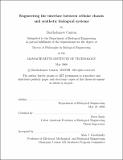Engineering the interface between cellular chassis and synthetic biological systems
Author(s)
Canton, Bartholomew (Bartholomew John)
DownloadFull printable version (5.220Mb)
Other Contributors
Massachusetts Institute of Technology. Biological Engineering Division.
Advisor
Drew Endy.
Terms of use
Metadata
Show full item recordAbstract
The aim of my thesis is to help enable the engineering of biological systems that behave in a predictable manner. Well-established techniques exist to engineer systems that behave as expected. Here, I apply such techniques to two aspects of the engineering of biological systems. First, I address the design and construction of standard biological devices in a manner that facilitates reuse in higher-order systems. I describe the design and construction of an exemplar device, an engineered cell-cell communication receiver using standard biological parts (refined genetic objects designed to support physical and functional composition). I adopt a conventional framework for describing the behavior of engineered devices and use the adopted framework to design and interpret experiments that describe the behavior of the receiver. The output of the device is the activity of a promoter reported in units of Polymerases Per Second (PoPS), a common signal carrier. Second, I begin to address the coupling that exists between engineered biological systems and the host cell, or chassis. I propose that the coupling between engineered biological systems and the cellular chassis might be reduced if fewer resources were shared between the system and the chassis. I describe the construction of cellular chassis expressing both T7 RNA polymerases (RNAP) and orthogonal ribosomes that are unused by the chassis but are available for use by an engineered system. I implement a network in which the orthogonal ribosomal RNA and the gene encoding T7 RNAP are transcribed by T7 RNAP. In turn, the orthogonal ribosomes translate the T7 RNAP message. In addition, the T7 RNAP and orthogonal ribosomes express a repressor that inhibits transcription of both the T7 RNAP and orthogonal ribosomes. (cont.) As a result, the orthogonal RNAP and ribosomes are auto-generating and self-regulating. The provision of resources unused by the cellular chassis and dedicated to an engineered biological system forms the beginnings of a biological virtual machine.
Description
Thesis (Ph. D.)--Massachusetts Institute of Technology, Biological Engineering Division, 2008. This electronic version was submitted by the student author. The certified thesis is available in the Institute Archives and Special Collections. Includes bibliographical references (p. 165-176).
Date issued
2008Department
Massachusetts Institute of Technology. Department of Biological EngineeringPublisher
Massachusetts Institute of Technology
Keywords
Biological Engineering Division.